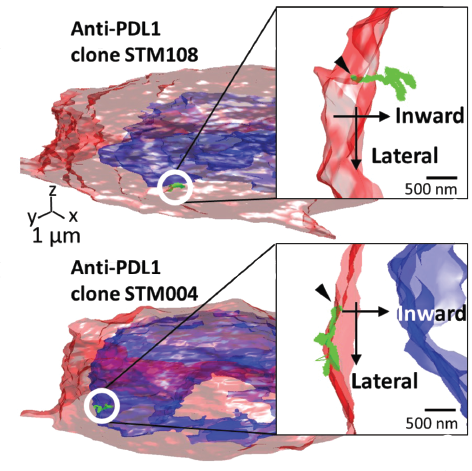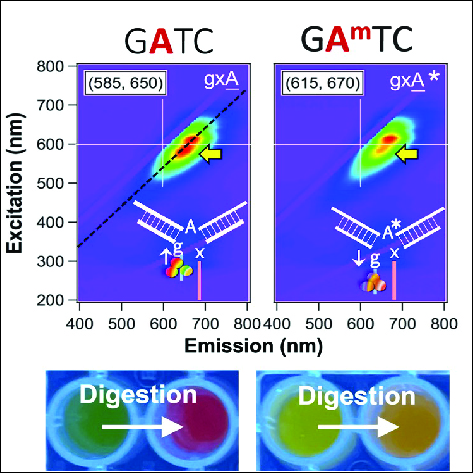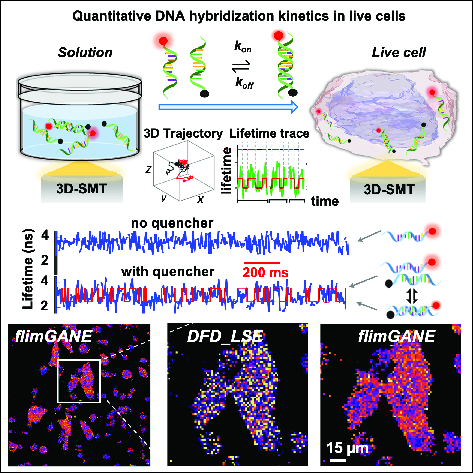Our research is focused on creating and studying new nanomaterials that have the potential to be used as future molecular probes (i.e., nanobiosensors) with unprecedented sensing capabilities, and developing new imaging tools for fundamental biomedical research at the single-molecule, single-cell level.

-
Deep and high-resolution 3D tracking of single particles
Single-particle tracking (SPT) has enabled direct observations of particle dynamics with sub-millisecond temporal resolution and submicron spatial resolution inside complex biological systems. Molecular trafficking within cells, tissues, and engineered 3D multicellular models is critical to the understanding of the development and treatment of various diseases including cancer. To achieve deep and high-resolution 3D tracking, we have developed a two-photon, 3D single-particle tracking (2P-3D-SPT) method capable of tracking particles at depths up to 200 μm in scattering samples with 22/90 [xy/z] nm spatial localization precision and 50 µs temporal resolution. At shallow depths, the localization precision can be as good as 35 nm in all three dimensions. We then demonstrate tracking of EGFR (Epidermal Growth Factor Receptor) complexes tagged with fluorescent beads in tumor spheroids, demonstrating deep 3D SPT in multicellular models. More details can be found in Liu, ACS Nano, 2020.

-
Silver nanocluster biosensors and fluorogenic aptamers
Among those water-soluble noble metal nanoclusters newly developed, DNA-templated silver nanoclusters (DNA/AgNCs) have attracted great interest in biosensing owing to a number of useful photophysical and photochemical properties. Controlled conversion of DNA/AgNCs between bright and dark states by guanine proximity has led to the invention of a new molecular probe, termed a NanoCluster Beacon (NCB), that “lights up” upon binding with a DNA target. We hold 3 US patents on the silver nanocluster probes (10407715, 9499866, 8476014) and are currently collaborating with Dr. Jennifer Brodbelt in UT Chemisty and Dr. Minjun Kim at SMU in using mass spectrometry and nanopores to study DNA/AgNCs. More details can be foud in Obliosca et al., ACS Nano, 2014; Chen et al., JACS, 2015; Blevins et al., ACS Nano, 2019; Kuo et al., Adv. Materials, 2022. We are currently using deep learning models to predictively design silver nanocluster sensors with desired colors, on/off ratios and photostabilities.

-
Time-resolved fluorescence measurement and imaging
Single-molecule detection provides researchers with a unique method to probe kinetics of biomolecules in their native environment, without the need to synchronize the molecular states. In contrast to other confocal-feedback 3D single-particle tracking demonstrations, we tracked single DNA reporter strands inside a live cell and measured their annealing-melting kinetics. Our 3D-SMT method uses multiple single-photon detectors or multiplexed pulsed laser illuminations to achieve spatial filtering, which not only allows for high-resolution 3D localization of single molecules in live cells, but enables simultaneous characterization of molecular binding state through a continuous lifetime measurement. The data acquired can be used to generate new models that can predict in-cellulo hybridization kinetics from sequence, study the molecular crowding inside cells and probe the cellular development and transition states. More details can be found in Chen et al, Nanoscale, 2023.


